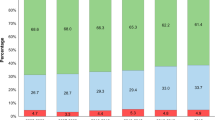Abstract
Empirically rigorous studies of nursing labor supply have to date relied on extant secondary data and focused almost exclusively on the role of pay. Yet the conditions under which nurses work and the timing and convenience of the hours they work are also important determinants of labor supply. Where there are national pay structures and pay structures are relatively inflexible, as in nursing in European countries, these factors become more important. One of the principal ways in which employers can improve the relative attractiveness of nursing jobs is by changing these other conditions of employment. This study uses new primary data to estimate an extended model of nursing labor supply. It is the first to explore whether and how measures of non-pecuniary workplace characteristics and observed individual (worker) heterogeneity over non–pecuniary job aspects impact estimates of the elasticity of hours with respect to wages. Our results have implications for the future sustainability of an adequately sized nurse workforce and patient care especially at a time when European healthcare systems are confronted with severe financial pressures that have resulted in squeezes in levels of healthcare funding.
Similar content being viewed by others
Notes
While “Agenda for Change” does have provision for recruitment and retention premia at the national and local levels, limited use has been made of this option. The new system explicitly sets out criteria and procedure for offering premia and as such can be argued will tend to make the pay structure more rigid than under the previous system where drift may adjust for local labor market conditions.
Previous studies on nurses’ labor supply that have used secondary data were also based on relatively small samples. Skåtun et al. [3] used information on 1076 nurses from the Quarterly Labour Force Survey whilst Rice [8] based his study on 287 nurses and midwives in the British Household Panel Survey.
We acknowledge that accepting the null hypothesis of no selectivity bias does not come as a surprise and may simply be an artefact of the sampling given that 95 % of the sample of nurses participate in the NHS nursing labor market and hence the correction for the participation decision is unlikely to ‘fully’ correct for the decision to supply labor as a nurse or in other occupations.
The results of the selectivity-corrected hours model are available as additional material. Note also that the parameter estimates are quite stable across the different model specifications.
This was particularly an issue with the introduction of the new pay and grading structure where not all respondents were necessarily aware of the new terminology. Respondents were therefore given the choice of providing their earnings through bands, grades, and/or points with additional choices for where on the grade/band spectrum if no specific point was known. Information on band or grade, point, or range within scales was used in conjunction with published pay bands and points as of November 2007.
These include unemployment, child, housing/council, incapacity or any other state benefits as well as income support, child tax credit, working tax credit, job seekers allowance, statutory sick pay and maternity allowance/statutory maternity pay.
References
OECD: OECD Health at a glance 2013. http://www.oecd.org/els/health-systems/Health-at-a-Glance-2013.pdf (2013)
Simeons, S., Villeneuve, M., Hurst, J.: Tackling nurse shortages in OECD countries. http://www.oecd.org/health/health-systems/34571365.pdf (2005)
Skåtun, D., Antonazzo, E., Scott, A., et al.: The supply of qualified nurses: a classical model of labour supply. Appl Econ 37, 57–65 (2005)
Altonji, J.G., Paxson, C.H.: Job characteristics and hours of work. In: Ehrenberg, R.G. (ed.) Research in Labor Economics, pp. 1–55. Jai Press INC., London (1986)
Antonazzo, E., Scott, A., Skatun, D., et al.: The labour market for nursing: a review of the labour supply literature. Health Econ 12, 465–478 (2003)
Shields, M.A.: Addressing nurse shortages: what can policy makers learn from the econometric evidence on nurse labour supply? Econ J 114, F464–F498 (2004)
Askildsen, J.E., Baltagi, B.H., Holmås, T.H.: Wage policy in the health care sector: a panel data analysis of nurses’ labour supply. Health Econ 12, 705–719 (2003)
Rice, N.: The labour supply of nurses in the UK: evidence from the British Household Panel Survey. http://www.york.ac.uk/res/herc/documents/wp/05_10.pdf (2005)
Kankaanranta, T., Rissanen, P.: The labor supply of registered nurses in Finland: the effect of wages and working conditions. Eur J Health Econ 10, 167–178 (2009)
Hanel, B., Kalb, G., Scott, A.: Nurses’ labour supply elasticities: the importance of accounting for extensive margins. J Health Econ 33, 94–112 (2014)
Heckman, J.J.: Sample selection bias as a specification error. Econometrica 47, 153–161 (1979)
Makepeace, G., Marcenaro-Gutierrez, O.: The earnings of workers covered by pay review bodies: evidence from the labour force survey. http://www.ome.uk.com/Document/Default.aspx?DocumentUid=F285548E−9F4B-4827-A64B-08B92D139FEC (2005)
Buchan, J., Seccombe, I.: An incomplete plan. The UK nursing labour market review 2008. http://www.rcn.org.uk/__data/assets/pdf_file/0015/201282/003302.pdf (2008)
Buchan, J., Seccombe, I.: Fragile future? A review of the UK Nursing Labour Market in 2003. http://www.rcn.org.uk/__data/assets/pdf_file/0006/78630/002468.pdf (2004)
Government Statistical Service: NHS hospital and community health services. Non-medical staff. England 1997–2007. http://www.ic.nhs.uk/webfiles/publications/nhsstaff2007/non%20med/Non-Medical%20Staff%20Bulletin%201997-2007.pdf (2008)
Heyes, A.: The economics of vocation or ‘why is a badly paid nurse a good nurse’? J Health Econ 24, 561–569 (2005)
Barigozzi, F., Turati, G.: Human health care and selection effects. Understanding labor supply in the market for nursing. Health Econ 21, 477–483 (2012)
Elliott, R.F., Ma, A.H.Y., Scott, A. et al.: Geographically differentiated pay in the labour market for nurses. J Health Econ 26, 190–212 (2007)
Smith, A.: An inquiry into the nature and causes of the wealth of nations. University of Chicago Press, Chicago (1977)
Rosen, S.: The theory of equalizing differences. In: Ashenfelter, O., Layard, R. (eds.) Handbook of Labor Economics, pp. 641–692. North Holland, Amsterdam (1986)
Phillips, V.L.: Nurses’ labor supply: participation, hours of work, and discontinuities in the supply function. J Health Econ 14, 567–582 (1995)
Chiha, Y.A., Link, C.R.: The shortage of registered nurses and some new estimates of the effects of wages on registered nurses labor supply: a look at the past and a preview of the 21st century. Health Policy 64, 349–375 (2003)
Clark, A.E.: Job satisfaction and gender: why are women so happy at work? Labour Econ 4, 341–372 (1997)
Shields, M.A., Ward, M.: Improving nurse retention in the National Health Service in England: the impact of job satisfaction on intentions to quit. J Health Econ 20, 677–701 (2001)
Euwals, R.: Female labour supply, flexibility of working hours, and job mobility. Econ J 111, 120–134 (2001)
Acknowledgments
We are grateful for the thoughtful comments of two referees. We would also like to thank conference participants at the Scottish Economic Society Conference and seminar participants at Newcastle University. Receipt of financial support from the ESRC is gratefully acknowledged (RES-000-23-1240). The Health Economics Research Unit is funded by the Chief Scientist Office of the Scottish Government Health and Social Care Directorates. The views expressed in this article are solely those of the authors.
Author information
Authors and Affiliations
Corresponding author
Electronic supplementary material
Below is the link to the electronic supplementary material.
Appendix
Rights and permissions
About this article
Cite this article
Eberth, B., Elliott, R.F. & Skåtun, D. Pay or conditions? The role of workplace characteristics in nurses’ labor supply. Eur J Health Econ 17, 771–785 (2016). https://doi.org/10.1007/s10198-015-0733-6
Received:
Accepted:
Published:
Issue Date:
DOI: https://doi.org/10.1007/s10198-015-0733-6




